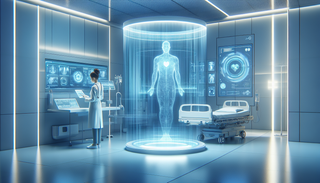
Why health-care AI suddenly feels real
Hospitals have flirted with artificial intelligence for decades, but 2025 feels different. Two forces converged: transformer models that can read and write clinical language almost as well as residents, and sharply cheaper cloud GPUs that make training on sensitive, in-house data feasible. Health systems from Boston to Bangalore now run pilots that would have sounded like science fiction five years ago—AI that drafts progress notes, triages emergency-room X-rays, or pages an intensivist when a patient’s vitals fit the profile of brewing sepsis.
When researchers at Duke University recently published a framework for AI safety in clinical settings, they were reacting to a surge of real deployments, not speculative hype. Their study found that large-language-model scribes trimmed physician note-taking by 20 percent and after-hours screen time by nearly a third[2]. The productivity bump is tangible enough that health systems are racing each other to integrate the technology before burnout claims more staff.
Diagnostics re-imagined
Radiology was the first frontier—pattern-recognition heaven for convolutional nets—but today the diagnostic spotlight is broader. Machine-learning models now crunch multi-modal data: textual symptoms, lab values, wearable streams, even voice tremors picked up during a telehealth call. The output is less a final verdict than a ranked set of differentials, letting clinicians focus cognitive effort where it matters.
A vivid example comes from surgical suites. In February, an international team showed that a generative model could write post-operative summaries more accurately than human surgeons, reducing omissions around complications and implanted devices[1]. Errors in these notes ripple through a patient’s continuum of care; automating away a chunk of them is not just clerical polish—it is risk reduction.
The same approach is creeping into cancer screening. FDA-cleared algorithms now highlight suspicious pixels on mammograms and lung CTs, flagging roughly 10 percent more early-stage tumors than radiologists working alone. The radiologist still signs the report, but AI has become the colleague who never blinks.
Smart hospitals, leaner operations
Diagnosis grabs headlines, yet the quiet revolution is logistical. Predictive models forecast bed occupancy days ahead, letting administrators postpone elective surgeries before hallway stretchers pile up. Computer-vision systems track infusion pumps and wheelchairs in real time, slashing the hours nurses spend hunting for equipment. When analysts at Frost & Sullivan sized the “smart hospital” market, they projected it would balloon to US$148 billion by 2029—double earlier estimates—driven largely by AI orchestration layers.
Digital twins of entire wards are even being used to rehearse a day’s patient flow, tweaking staffing mixes in simulation before anyone clocks in. In an era of chronic clinician shortages, squeezing an extra percentage point of efficiency out of the system can translate directly into saved lives.
Keeping humans in the loop
Hospitals adopting AI the fastest insist on a human-in-the-loop model: the algorithm proposes, the clinician disposes. The stance is partly cultural—liability laws still point a finger at licensed professionals—but it is also pragmatic. No model is perfectly calibrated across every demographic slice, and statistical quirks can masquerade as medical insight.
Duke’s safety framework outlines red-flag scenarios: opaque scoring systems that trigger interventions without explanations, or models trained on one hospital’s affluent patient base but deployed in safety-net clinics where comorbidities look different. The authors argue that every clinical AI should ship with a “model facts label” akin to pharmaceutical inserts—indications, contraindications, side-effects, and the population on which it was tested.
Risks, regulations and the road ahead
Regulators have noticed. The U.S. Food and Drug Administration’s new Software-as-a-Medical-Device draft guidance introduces a “predetermined change protocol,” forcing vendors to spell out how their model will adapt once it meets real-world data. In Europe, the AI Act is poised to classify most diagnostic algorithms as “high risk,” subjecting them to mandatory human oversight and audit trails.
Yet innovation is unlikely to slow. Open-source toolkits such as MONAI and BioGPT lower the barrier for clinicians with a bit of Python skill to prototype bespoke models on local data. Meanwhile, cloud providers now offer zero-knowledge training enclaves, promising privacy compliance without on-prem hardware.
The next inflection point may be personalized AI copilots that follow a patient across settings: smartwatch, home sensor hub, clinic visit, and eventual hospital stay. Instead of a dozen siloed algorithms, one longitudinal model could nudge a cardiologist about subtle deterioration weeks before a readmission.
Technically, the pieces exist: large language models that parse any modality, reinforcement learners that adapt to individual baselines, and federated-learning protocols that keep data decentralized. What remains is stitching them into a tapestry that respects privacy, equity, and the messy realities of clinical life.
Bottom line
AI diagnosticians will not replace doctors, but they are already reshaping the texture of medicine. The stethoscope took 25 years to move from curiosity to standard gear; electronic health records, almost 40. By contrast, generative and predictive AI have compressed that diffusion curve into half a decade. The hospitals that treat algorithms as teammates rather than threats are beginning to post the metrics—fewer errors, faster beds, happier staff—that will pressure laggards to follow. The era of quiet transformation is ending; the next one will be loud.
Sources
- Reuters – “Health Rounds: AI tops surgeons in writing post-operative reports”
- Axios – “Duke researchers examine AI safety in a health care setting”